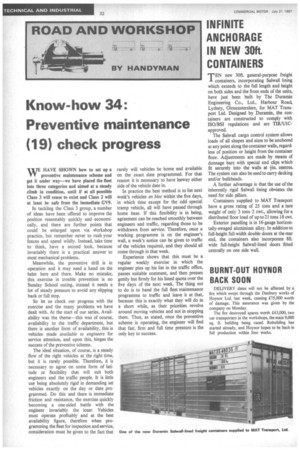Know-how 34: Preventive maintenance (19) check progress
Page 34

If you've noticed an error in this article please click here to report it so we can fix it.
%/EHAVE SHOWN how to set up a preventive maintenance scheme and get it under way—we have placed the fleet into three categories and aimed at a steady climb in condition, until if at all possible Class 3 will cease to exist and Class 2 will at least be safe from the immediate GV9.
In tackling the Class 3 group, a number of ideas have been offered to improve the position reasonably quickly and economically, and there are further points that could be enlarged upon via Workshop practice, but remember never to rush your fences and spend wildly. Instead, take time to think, have a second look, because invariably there is a practical answer to most mechanical problems.
Meanwhile, the preventive drill is in operation and it may need a hand on the helm here and there. Make no mistake, this exercise in trouble prevention is no Sunday School outing, instead it needs a lot of steady pressure to avoid any slipping back or full stop.
So let us check our progress with the exercise and the many problems we have dealt with. At the start of our series, Availability was the theme—this was of course, availability to the traffic department, but there is another form of availability, this is vehicles made available to engineers for service attention, and upon this, hinges the success of the preventive scheme.
The ideal situation, of course, is a steady flow of the right vehicles at the right time, but it is rarely possible. Therefore, it is necessary to agree on some form of latitude or flexibility that will suit both engineers and the traffic people. It is little use being absolutely rigid in demanding set vehicles exactly on the day or date programmed. Do this and there is immediate friction and resistance, the exercise quickly becoming a one-sided battle with the engineer invariably the loser. Vehicles must operate profitably and at the best availability figure, therefore when programming the fleet for inspection and service, consideration must be given to the fact that rarely will vehicles be home and available on the exact date programmed. For that reason it is necessary to have leeway either side of the vehicle date in.
In practice the best method is to list next week's vehicles en bloc within the five days, in which time except for the odd special tramp vehicle, all will have passed through home base. If this flexibility is in being, agreement can be reached smoothly between engineers and traffic, regarding those to be withdrawn from service. Therefore, once a working programme is on the engineer's wall, a week's notice can be given to traffic of the vehicles required, and they should all come through in that week.
Experience shows that this must be a• regular weekly exercise in which the engineer pins up his list in the traffic office, passes suitable comment, and then presses gently but firmly for his listed quota over the five days of the next week. The thing not to do is to hand the full fleet maintenance programme to traffic and leave it at that, because this is exactly what they will do in a short while, as their priorities revolve around moving vehicles and not in stopping them. Thus, as stated, once the preventive scheme is operating, the engineer will find that fair, firm and full time pressure is the only key to success.












































































































